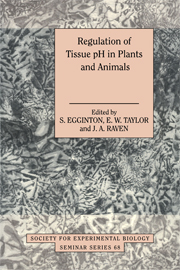Book contents
- Frontmatter
- Contents
- List of contributors
- Preface
- Measurement of intracellular pH: a comparison between ion-sensitive microelectrodes and fluorescent dyes
- pH-sensitive microelectrodes: how to use them in plant cells
- The use of nuclear magnetic resonance for examining pH in living systems
- Invasive studies of intracellular acid–base parameters: quantitative analyses during environmental and functional stress
- Lactate, H+ and ammonia transport and distribution in rainbow trout white muscle after exhaustive exercise
- Limiting factors for acid–base regulation in fish: branchial transfer capacity versus diffusive loss of acid–base relevant ions
- H+-mediated control of ion channels in guard cells of higher plants
- pH regulation of plants with CO2-concentrating mechanisms
- Intracellular pH regulation in plants under anoxia
- The role of turtle shell in acid–base buffering
- Acid–base regulation in crustaceans: the role of bicarbonate ions
- A novel role for the gut of seawater teleosts in acid–base balance
- pH and smooth muscle: regulation and functional effects
- Regulation of pH in vertebrate red blood cells
- Acid–base regulation in hibernation and aestivation
- Hepatic metabolism and pH in starvation and refeeding
- Back to basics: a plea for a fundamental reappraisal of the representation of acidity and basicity in biological solutions
- Index
Limiting factors for acid–base regulation in fish: branchial transfer capacity versus diffusive loss of acid–base relevant ions
Published online by Cambridge University Press: 22 August 2009
- Frontmatter
- Contents
- List of contributors
- Preface
- Measurement of intracellular pH: a comparison between ion-sensitive microelectrodes and fluorescent dyes
- pH-sensitive microelectrodes: how to use them in plant cells
- The use of nuclear magnetic resonance for examining pH in living systems
- Invasive studies of intracellular acid–base parameters: quantitative analyses during environmental and functional stress
- Lactate, H+ and ammonia transport and distribution in rainbow trout white muscle after exhaustive exercise
- Limiting factors for acid–base regulation in fish: branchial transfer capacity versus diffusive loss of acid–base relevant ions
- H+-mediated control of ion channels in guard cells of higher plants
- pH regulation of plants with CO2-concentrating mechanisms
- Intracellular pH regulation in plants under anoxia
- The role of turtle shell in acid–base buffering
- Acid–base regulation in crustaceans: the role of bicarbonate ions
- A novel role for the gut of seawater teleosts in acid–base balance
- pH and smooth muscle: regulation and functional effects
- Regulation of pH in vertebrate red blood cells
- Acid–base regulation in hibernation and aestivation
- Hepatic metabolism and pH in starvation and refeeding
- Back to basics: a plea for a fundamental reappraisal of the representation of acidity and basicity in biological solutions
- Index
Summary
Introduction
Metabolic energy production, indispensable for the maintenance of life, relies essentially on the regulation of pH as a central parameter for the involved processes. Deviation by more than a few tenths of a pH unit may considerably reduce metabolic flux or even completely inhibit further energy production on the basis of pronounced pH activity optima of certain key enzymes (such as phosphofructokinase) (see Heisler, 1990b). Tight regulation of pH is accordingly indispensable for conservation of homeostasis.
In fish, pH regulation is extensively challenged by changes of the environment: utilization of water as the gas exchange medium frequently subjects fish to large and rapid changes in water O2 and CO2 concentrations, in temperature and in environmental electrolytes, and to various other natural or human-induced stress factors that air breathers never encounter to any comparable extent. This chapter focuses on the description of characteristics, sites and mechanisms of fish integumentary acid–base regulation, with particular emphasis on the limitations of active and passive components contributing to the overall regulatory pattern. Due to limitations of space, the reader is referred to review articles wherever appropriate.
Regulatory mechanisms
Mechanisms for acid–base regulation are common to all living organisms and are essentially the same for fish as for terrestrial animals. The extent to which individual mechanisms are utilized, however, is quite different. The situation for fish is characterized by the intimate contact with an aqueous environment, generally including continuous immersion and utilization of water as the gas exchange medium.
- Type
- Chapter
- Information
- Regulation of Tissue pH in Plants and AnimalsA Reappraisal of Current Techniques, pp. 125 - 154Publisher: Cambridge University PressPrint publication year: 1999
- 2
- Cited by



